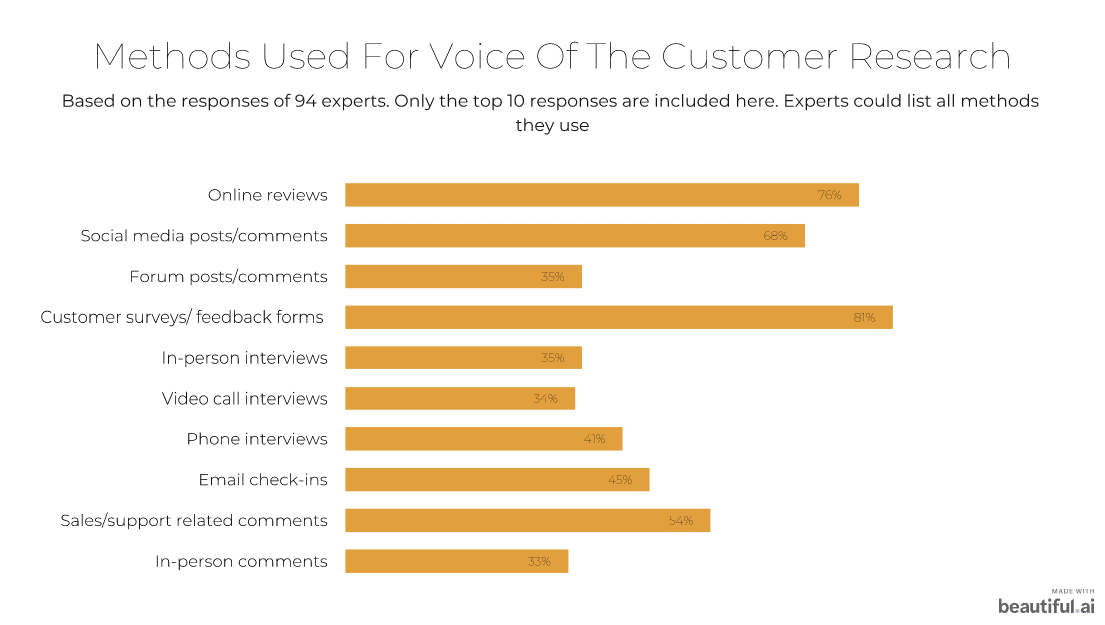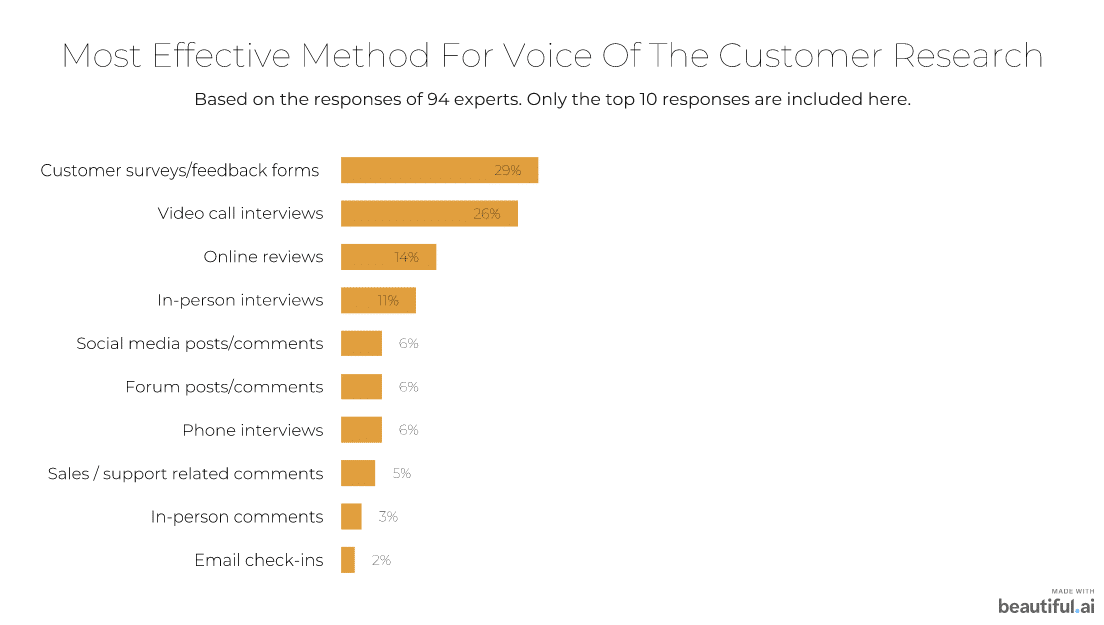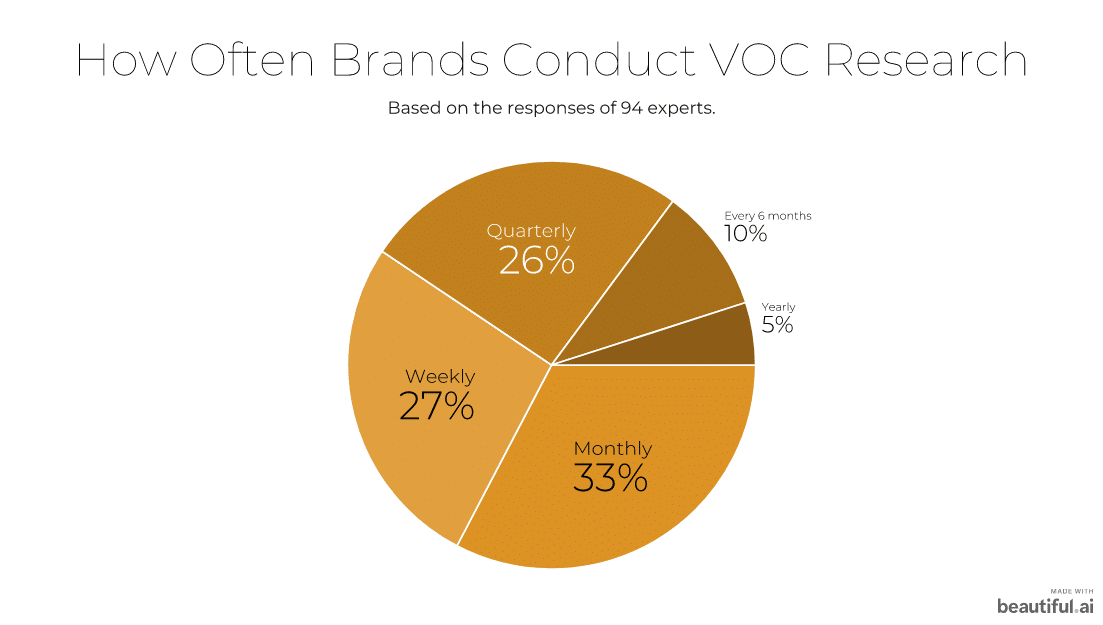Businesses that serve their customers are businesses that succeed. That’s a given.
But hang on. Can you really tell how satisfied your customers are?
Enter: Voice of the customer research that unearths what’s on your customers’ minds and what they say about your business behind your back. Asking the right questions is important, of course. But it’s also crucial to use the most effective methodology and conduct the research correctly.
In this piece, we walk you through the most effective voice of the customer research methods used by experts, as well as tips to get the most from all your research.
Let’s get on with it.
What are the most effective voice of the customer research methods?
Of the 90+ experts we talked to, the majority use customer surveys and feedback forms to learn about their customer’s voice.
Other popular methods include online reviews (76% use them), social media listening (68% read comments, posts, etc.), and gathering comments from sales and customer support communication (54% do that).
Email check-ins and phone interviews are next, followed by exploring forums, in-person interviews, video call interviews, and in-person comments trailing at the end.

But how effective are these methods?
The most widely used customer research method, customer surveys and feedback forms, are also rated as the most effective method (29%). Video call interviews are the second most effective method for voice of the customer research (26%).
A handful of experts noted that online reviews (14%) and in-person interviews (11%) are also effective. Only 2% thought email check-ins are most effective.

For more about what types of customer surveys to send, check out our articles on Net Promoter Score (NPS) questions and other customer satisfaction surveys.
For research to be effective, however, we know it’s not enough to just do it once. Customers change.
So how often do other marketers conduct voice of the customer research?
The majority 33% conduct research monthly, while 27% make it a weekly task. Another 26% prefer conducting research quarterly, with 10% researching only once every six months.

18 top voice of the customer research tips
Now, on to the meaty bits: What are actionable ways you can best leverage a voice of the customer program? We gathered 18 tips from top experts.
1. Leverage two-way communication
Researching your customers’ thoughts should always be two-way, with you on the other end, prodding them to share more details. To this end, a mix of surveys (one-way communication) and live chat with interview calls (two-way communication) is ideal.
Mikkel Andreassen from Dixa is a fan of the latter. Andreassen shares, “My best tip is to use live chat, or any form of two-way communication, when reaching out for VoC information.”
The reason? “You want to allow customers to describe their experience in detail, with a live agent on the other side. This way the experience isn’t stagnant, such as a routine email survey, and more interactive for the customer in every way. Conversational data analytics can then turn these conversations into accessible digital data that you can analyze.”
2. Get rid of template-based questions
While templates help you save time, these can also clog your conversation – preventing it from taking a natural course. Not to mention, template-based questions can make the entire conversation feel robotic.
Ditch template-based questions, as LeapVista’s Steve Tan suggests. Instead, “craft questions that fit your VoC research objective.
“If you’re using survey forms, for example, don’t simply reuse the same form over and over again. Create a specific goal every time, and ensure the questions you’re asking – ideally a blend of checkbox and open-ended questions – are relevant to that goal behind the survey.”
For every round of research, go through your objective and jot down fresh questions that help you meet this objective. But remember: The goal is to use those questions as an outline or guide to help direct the conversation.
3. Ask open-ended questions
“While you’re conducting primary research and attempting to better understand the market, one of the worst mistakes you can make is relying on ‘Yes’/’No’ style questions,” observes Anil Ramsey from ChairsFX. These closed questions “cripple your qualitative data and give you a lot less to work with.”
To gain the most customer insight, ask open-ended user testing questions that put your customer into deep thought and prompt them to share details.
You can also see them as ‘how’ or ‘what’ style questions, as Ramsey points out.
Dan Barba echoes the same. “To make the most out of your customer voice research, you need to give your audience a chance to elaborate on their thoughts fully and in detail. Avoid ‘Yes’ or ‘No’ questions as much as you can; they’ll only take you so far.”
4. Start broad
Ronnie Teja of SoftwareKeep advises you to first set the mode of the conversation, and then slowly taking the tempo up.
“When asking questions, start broad,” says Teja. “Don’t start by being too specific. You might be surprised if for once you thought customers are more concerned about your customer service, yet their main concern is about the packaging.”
5. Use the three-word method
ScrapingBee’s Kevin Sahin has another type of question format you can easily work into your VoC strategy.
It looks like this: “Ask your customers how they’d describe your company in three words.”
“This sentiment is very telling of how well you’re servicing your audience. You can average the results and come out with the most frequently used three words to structure your audience matrix.” says Sahin. “Of course, sentiments can change month by month – that’s why it’s so important to keep on top of it.”
Using a three-word method, you can also identify the words that your customers use to describe your business. Then, use those words to write your website and landing page copy. This way, you’ll be accurately describing your business in the way your customers do.
6. Never rush customer research
According to AJ Brown from LeadsRX, rushing customer interviews can make them feel nervous or uncomfortable.
In contrast, your primary goal is to make a customer feel comfortable as you can. It’s only then that they’ll open up to you and share their honest thoughts (in detail) with you.
“Give it time,” Brown shares. “Rushing through a phone interview will make the human on the other end feel uncomfortable. This will undermine the basic trust required to answer questions honestly, fully, and with full consideration. No valuable insights are ever gained from ten questions run down in five minutes.”
7. Pay attention to social listening
There’s a lot you can learn simply by digging into what your customers are saying about you on social media. In fact, 96% of dissatisfied customers are less likely to complain to you and more likely to share their experience with 15 others.
Veronica Miller from VPNoverview observes that social listening gets you an “honest, unfiltered view of your customers’ feedback by monitoring how they feel about your brand and product when they aren’t speaking directly to you.”
What’s more, “social listening, like survey questions, will help you recognize consumers with whom you’d like to perform a more in-depth voice of customer study.”
Timmy Yanchun of LTHR Shaving notes, social is an excellent channel “not only to discover how your customers feel about their purchases, but to engage with them and learn even more.”
Social listening allows you to keep tabs on what customers are saying. Then, connecting with them allows you to have a more casual and real-time interaction.
8. Check out online reviews too
You’ll also find invaluable insight into the customers’ experience in online reviews.
In fact, Rochelle Burnside from Best Company goes on to say “the most authentic customer sentiment comes through reviews, and that’s why you should be organizing your reviews by complaint and compliment, and compiling data on feedback trends. This data can be what sells a new direction for your product research or reinforces your value proposition.”
Everlasting Comfort’s Travis Killian agrees. “Pay special attention to online reviews, as that’s what consumers are doing before they make a final purchase,” Killian attests. About nine out of ten consumers read reviews before they make a purchase, which highlights the need to pay attention to them.
Not to mention, “this is research you can easily find with a click. By replying to online reviews, you can discover even more about how your customers feel about their purchases.”
9. Hang out where your audience does
In addition to social media and online reviews, there’s a third platform that’s useful for getting a complete picture of your customers’ sentiment – online forums.
WinIt’s Ouriel Lemmel recommends to “get active on forums and communities where your customers gather and congregate. As a business owner or marketing team, you should have a firm grasp on the type of customer you’re catering to.
“For example, our business focuses on helping people dispute parking and traffic tickets, so we know our buyers are drivers and car owners, typically living in urban areas. It’s important to answer this question for your own business first and foremost: Who is your ideal customer? What kinds of people would your product or service appeal to?”
Once you’ve got the answers to these questions, go on to take the next step: “Visit forums and communities where your ideal customers gather and talk to each other. This could be Facebook groups or forums on sites like Reddit.com that are similar to your industry or niche.”
But be careful. Your goal here isn’t to sell your business. It’s to “engage in conversations and pick up on how customers talk. Learn about different vocabulary and lingo they use. This will help you develop an understanding of your ideal consumer’s voice, and you can use your own web copy and advertising materials to replicate that voice,” says Lemmel.
Brian Turner from Convert Binary applauds visiting forums too. Particularly, Reddit. Sharing his experience, Turner writes, “One of the greatest methods I have for understanding what my customers are thinking is to trawl through forums to see their conversations.
“A lot of the time the copy that we use comes directly from the customer’s mouth, which is indescribably valuable. It ensures that we are talking to our target audience in their voice.”
10. Run lots of tests and balance them
It’s also crucial you don’t limit the number of market research tests you run. On that note, you should “have a balance between in-person interviews and wider surveys,” observes Jill Canes from Face Forward Medical Aesthetics.
“Data collection from in-person interviews may not be representative of the wider base of customers. Surveys and social media are important to understand how representative the views of individual customers can be for the wider audience.”
Carol Tompkins from AccountsPortal is on the same page. “Leverage multiple sources of customer data in order to get comprehensive insights about your customers’ expectations and needs, and what they are saying about your product and brand.”
Caravan Digital’s Chris Ostergaard adds to this by pointing out, “When conducting surveys, customers will not always respond naturally or truthfully to questions about your brand. So while surveys are extremely valuable, you should also collect data when customers are unaware they are test subjects.”
Ostergaard lays out the process: “Once you’ve gone through your internet reviews and social comments, you should be starting to get a sense of your voice of the customer. Now comes the issue of getting it just right.
“A strategy that has always proved to work is A/B testing. Some of the tests we routinely run involve testing using comedic versus serious language, and active versus passive language.
“Conduct these tests at different stages and touchpoints of the customer journey. If the customer is more or less familiar with your product or services, they may react differently to different language styles. After every test you run, you’ll be getting a little closer to getting the voice of the customer exactly right.
“Don’t be afraid to run a vast number of tests, as they cut out speculation entirely! You’ll be able to report back exactly what customers prefer at different points.”
11. Make customer research a regular thing
Besides conducting lots of tests, make sure you’re researching your VoC data and metrics regularly.
“This ensures the voice of the customer is ingrained into core business processes and that the business is constantly acting on new customer feedback to improve,” reasons DealA’s Oleg Segal. “Get feedback regularly and have a process for analyzing customer data and making decisions to improve the customer experience.”
12. Be open to criticism
Now with your data, it’s also essential you understand the criticism your customers share.
This can be hard. But “even if your brand is your baby and you don’t love hearing criticism about it, it’s important to remember a brand is nothing without an audience,” says Kate MacDonnell of Coffee Affection. “Even if you don’t love what you’re hearing from a consumer, it’s important to have an open mind about what they’re saying.”
Jeff Shipwash from Shipwash Properties LLC. adds: “To grow your business, you need to understand the data that is working, and the data that is not working, Expand on the good feedback, and correct the negative feedback you get from your customers.
“You need to truly value each conversation you have with your customers. This is one area of business that cannot be ‘winged.’ If you start to wing it, you will ultimately lose control of your own brand.”
13. Make everything customer-focused
It’s also essential you “make sure your surveys, feedback forms, emails, and other customer support avenues are seamless, simplified, and customer-centric,” says Lily Ugbaja from Finding Balance.
“For example, instead of asking customers if they would do a repeat business, ask about customer satisfaction and if there’s anything more they would have wanted.”
14. Record the calls
According to Felly Day of Felly Day VA , recording all customer calls is essential for learning things from an observational point. In fact, something that didn’t click when you were on the call with the customer might do so later as you watch the recording.
“I might decide something the first time while we’re talking, but when re-watching from an observational point of view, I notice different points that were made (or weren’t made). And that’s when I have the breakthroughs in my copy,” Day elaborates.
15. Value your customer’s voice – and make sure your customer knows it
Always “prove that the customer voice is heard and valued,” says Jennie Lee Montgomery from EPOCH Clemson.
Montgomery shares her company shows its appreciation by “responding promptly and personally to both positive and negative reviews and social media comments, creating and communicating an action plan based on results of our resident experience surveys, and following up to any email, phone system, or in-person feedback with the appropriate measure.
“These responses encourage customers to give genuine and frequent feedback because they are assured their feedback matters and is meaningful in creating a positive experience with our product.”
16. Focus on customer relationships
Building relationships with your customers is the key to success here. Not only does it get your audience talking, it also drives customer loyalty.
“Keep an open line of communication with the customer so they feel comfortable sharing their feedback. Do so by checking in frequently,” says Golda Criddle from ReviewInc.
“It is also important to have many different ways customers can leave feedback. For example, provide texting, email, and private feedback as channels of communication.”
At Bobbie, Kathryn Schwab shares how they work on strengthening relationships with their customers. “We’ve aligned our marketing, sales, and customer success teams to focus on customer relationships. We rely on customer relationship management (CRM) software to keep track of existing customers, improve customer retention, and automate communication.
“We have found HubSpot CRM to be extremely helpful for our business. It has helped us to become more proactive in communicating with our customers and it provides insight to what messages and marketing are the most effective.”
17. Hire a third party for the research
Ray Blakney from Podcast Hawk advises: “If possible, try to hire a third party to conduct the research for you. For us, that has gotten us much more honest feedback – and, thus, a better understanding of the customer voice – from the people we speak with.
“If the customer knows the person they speak with is not part of the company being researched and won’t take anything personally, they usually share more.”
18. Be dedicated to discovering your voice of customer
Lastly, “be genuine about your research,” suggests Mike Germade from Restasy. “Don’t just ask questions for the sake of putting it into a document somewhere. Ask because you really want to know about the experience someone is having.”
Tying it all together
From sending surveys on a regular basis to creating a more customer-centered process, there’s a lot that we’ve covered today. Use these voice of the customer research tips to gain more insight into your own customer needs and opinions, and build a business that speaks directly to them.




